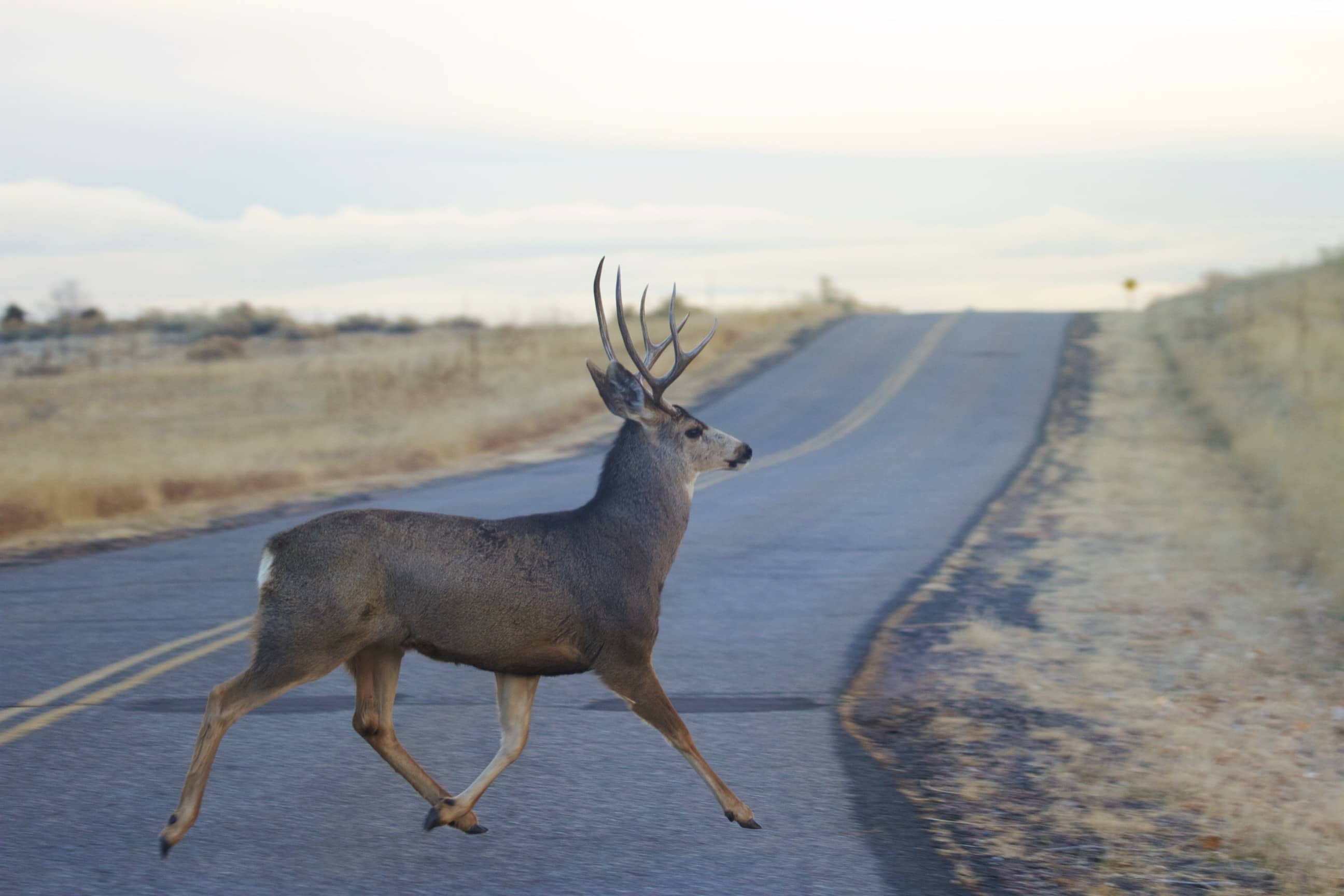
Mule deer are just one of many big game species benefitting from crossings managed for their safe transit across roads. DEO Photo by NDWF.
By John Bradley
On a recent road trip back from Denver, after exhausting all my podcast downloads and Spotify playlists, boredom struck, and in desperation to stay awake, I decided to count roadkill.
I’ve always called out game when driving, pointing out deer, antelope, or pheasants, while often annoying my passengers, but never roadkill. This impromptu “roadkill bingo” was triggered by a nice, and I mean a really nice pronghorn buck dead on the highway’s shoulder. I know it’s just one animal in a species, but it was sad to see a monarch meet it’s end that way.
On a 25 mile stretch of Highway 85, I counted over 20 animals who met a similar fate. That didn’t include the numerous skunks, rabbits, and other small, pancaked fur on the side of the road. Playing this grisly version of road trip bingo made it clear how numb we’ve become to seeing roadkill and how we’ve accepted it as a part of driving.
According to the Federal Highway Administration, drivers across the country hit an estimated 1.5 million animals each year. Nationally, it costs the us upwards of $8 billion, approximately 200 people die, 30,000 more are injured, not to mention the loss of wildlife from these collisions.
It’s a real problem.
Elk, mule deer, white tailed deer, pronghorn, bighorn sheep, and moose, North Dakota’s big game animals, are prominent species on our landscape, and their presence and abundance are highly valued by hunters, wildlife watchers, and the people who both live in and visit the state. Our big game, like most wildlife, need to move both daily and seasonally to thrive. Sadly, their habitats and travel routes are being fractured by challenges like fencing, expanding transportation infrastructure, hastily planned energy development, and increased traffic. While it may be difficult to agree on what to do about all these issues, one thing that we can agree on is wanting safer roadways.
From oil workers, farmers, and ranchers who use the highways for their livelihoods to the sportsmen and women, and tourists – animal collisions and the roadkill it leaves behind negatively impact our state. Preventing wildlife related collisions on our highways is a problem that’s worth solving.
Fortunately, there has been significant scientific progress in tracking wildlife movements over the last 20 years. This progress has helped our understanding of how big game species move day to day and how they use seasonal migration routes between their winter and summer ranges. Trail cameras have been essential on this front, revealing how animals react to new structures and fences, as well as when and how they navigate across roads. Wildlife that can’t pass freely through barriers and obstacles like roads and fences are changing their behavior and it is impacting their historical travel routes.
Appropriately, North Dakota Game & Fish have ramped up their efforts to enhance and restore migration routes among core wildlife habitats and reduce wildlife collisions. One such project, the Highway 85 underpass wildlife crossing, was constructed to let bighorn sheep safely move across the highway. According to the Department, and verified by their trail camera photos, big horn sheep have taken to using the underpass to safely move across the busy highway near the North Unit of Theodore Roosevelt National Park. But Bighorns aren’t the only animals that have benefitted from this safe passage route, mule deer have taken full advantage of the crossing.
To steal a line from Field of Dreams, this is proof that “if you build it, they will come.”
Obviously, one crossing won’t be enough to significantly decrease collisions on our roadways. We need more efforts at the state and federal level that conserve wildlife, support local economies, improve hunting and wildlife viewing opportunities, and safeguard centuries-old migrations. Wildlife crossings, like bridges, tunnels and culverts are a cheap and effective way to do just that. With D.C. focused on passing a large infrastructure package, the time is ripe to identify and invest in more wildlife friendly crossings across our state.
Keeping our roads clear of wildlife, preventing collisions, saving countless dollars, and protecting North Dakota’s cherished big game animals is something we can all get behind. Preventing wildlife collisions is a problem we can solve, there is no better time than now to solve it.
John Bradley is a Dakota Edge Outdoors contributing writer and the Executive Director of the North Dakota Wildlife Federation.
